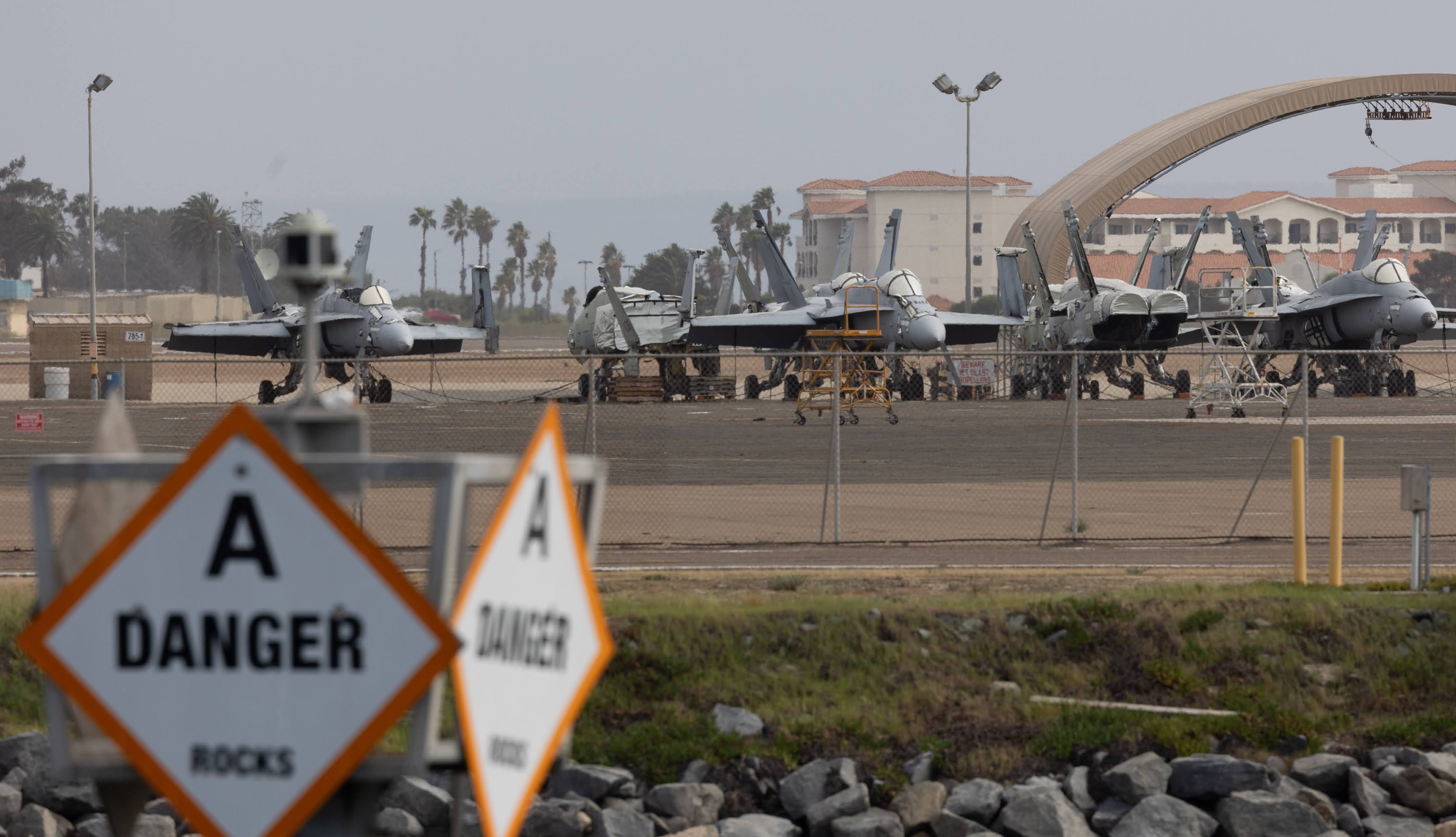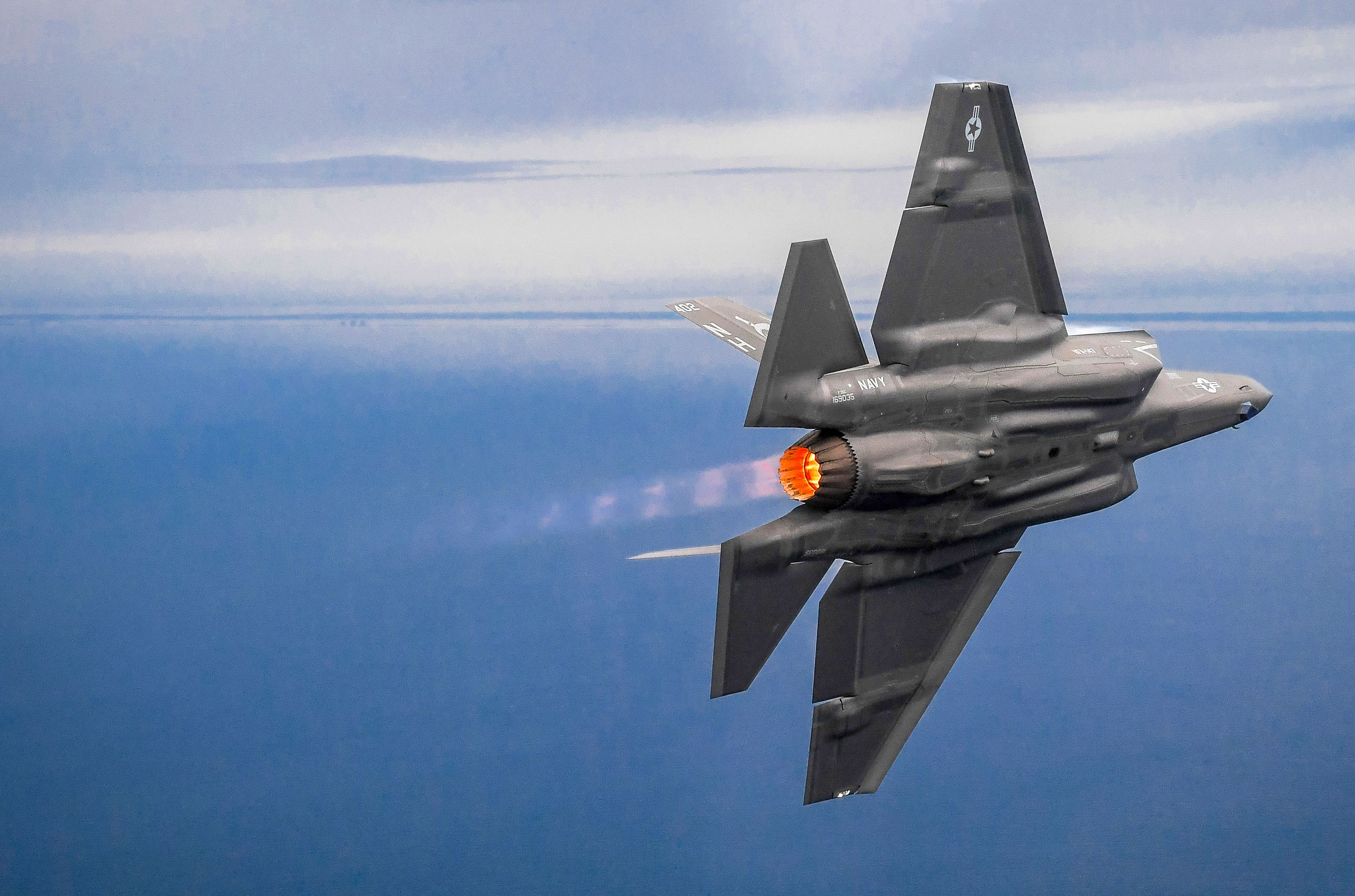
A U.S. Navy F-35C Lightning II, attached to Commander, Joint Strike Fighter Wing, the ‘Argonauts’ of Strike Fighter Squadron (VFA) 147, completes a flight over Eglin Air Force Base in Fort Walton Beach, Fla., Feb. 1, 2019. US Navy Photo
NAVAL AIR STATION NORTH ISLAND, Calif. – The Navy is making the first major changes to the carrier air wing in a generation. The service just wrapped up the first carrier deployment of the F-35C Lightning II Joint Strike Fighters – the first new fighter jet on a carrier in 20 years – and is a few years away from introducing the first unmanned aircraft into the air wing.
But while the Navy is moving ahead with new platforms and ways of fighting, it is still wrestling with maintenance gaps and a fighter inventory too small to deploy and train efficiently. The service is also shifting its strategy to focus on the Indo-Pacific, a vast region for the carrier air wing to operate in, after two decades of providing close-air support for combat missions in the Middle East and Central Asia.
In an interview last month with USNI News, Vice Adm. Kenneth Whitesell, the commander of Naval Air Forces and Naval Air Force Pacific, laid out his vision for blending fourth- and fifth-generation aircraft into the future carrier air wing and the transition to future sixth-generation systems.
Whitesell is also focused on remediating the backlog of Super Hornets waiting to enter the Service Life Modification program that will upgrade the aircraft and extend their service lives; implementing lessons from the first F-35C deployment to inform the future of carrier aviation; and ensuring it has enough fighters to meet its air wing requirements by 2025.
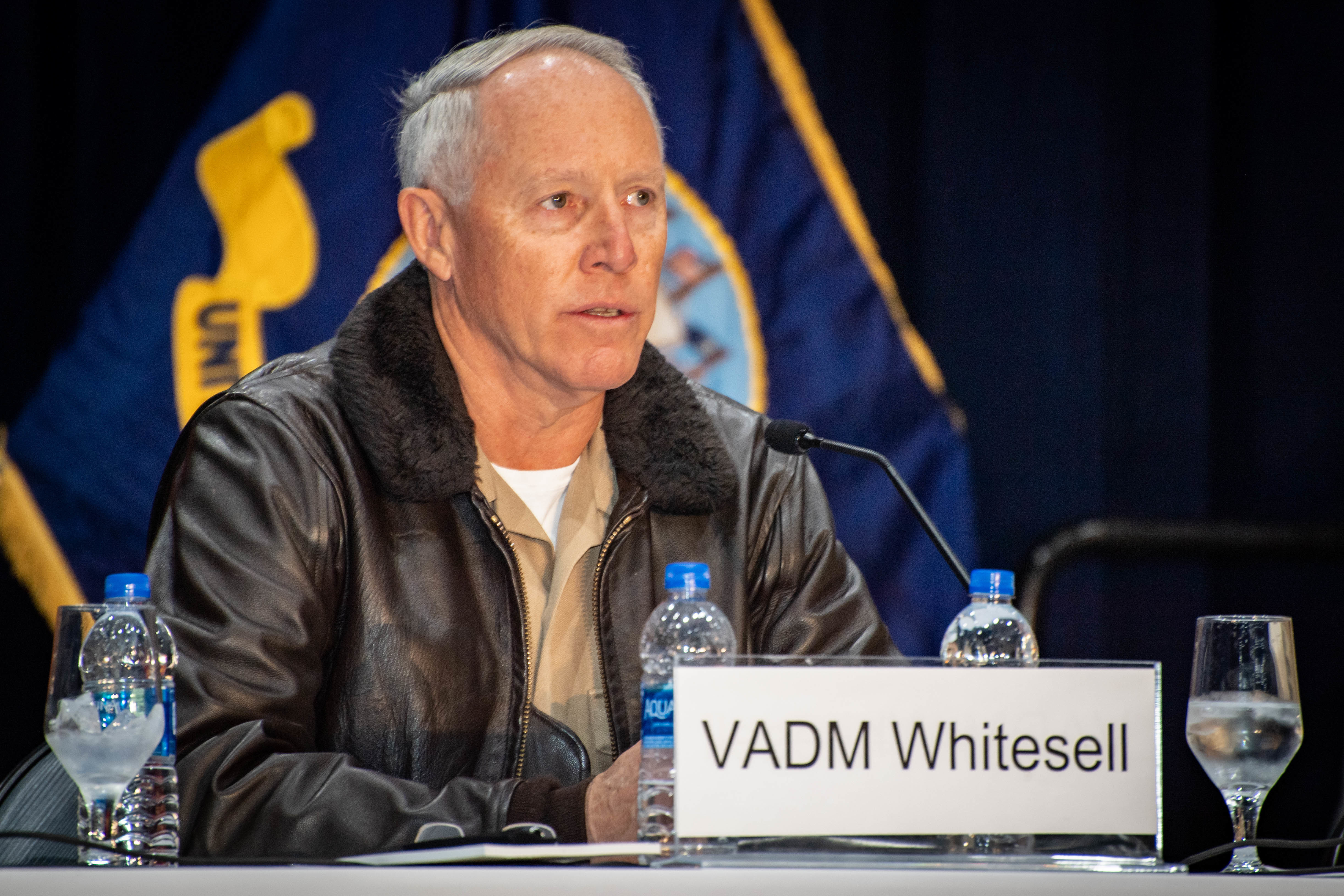
Vice Adm. Kenneth Whitesell, Commander, U.S. Naval Air Forces (CNAF), speaks at the West 2022 conference at the San Diego Convention Center, Feb. 16, 2022. US Navy Photo
“We’ve got a [master aviation plan]. We’ve got a strategy and the funding piece. We just worked last week with NAVAIR for program management – N98 for money coordination,” Whitesell said in a recent interview at his office. “As we build the MAP, we know where our deployments are roughly going to be and the modifications that have to be on the carrier and the modifications that have to be so that the air wing itself syncs – the capabilities, the [command and control], all the systems sync. So I’m pretty happy – I’m okay with where the strategy is right now. The lynchpin is going to be the funding piece.”
From modernizing the fourth-generation F/A-18E-F Super Hornets, to the ongoing integration of the F-35Cs into the carrier air wing, to a 2022 emphasis on cost-saving measures, Whitesell says U.S. naval aviation is on a path to eliminate fighter gaps in the next three years, while achieving new mission-capable rate goals affordably.
“We can’t afford the ultimate numbers that we have at this price that we’re paying today. We have to squeeze efficiencies out. And that is the 2022 focus for naval aviation, is the cost transformation,” Whitesell said, referring to the mission-capable rates the Navy uses to evaluate the readiness of its aircraft.
But Congress remains skeptical of the service’s math on its strike fighter shortfall, which the Navy says it can eliminate by 2025, five years sooner than anticipated.
‘Air Wing of the Future’
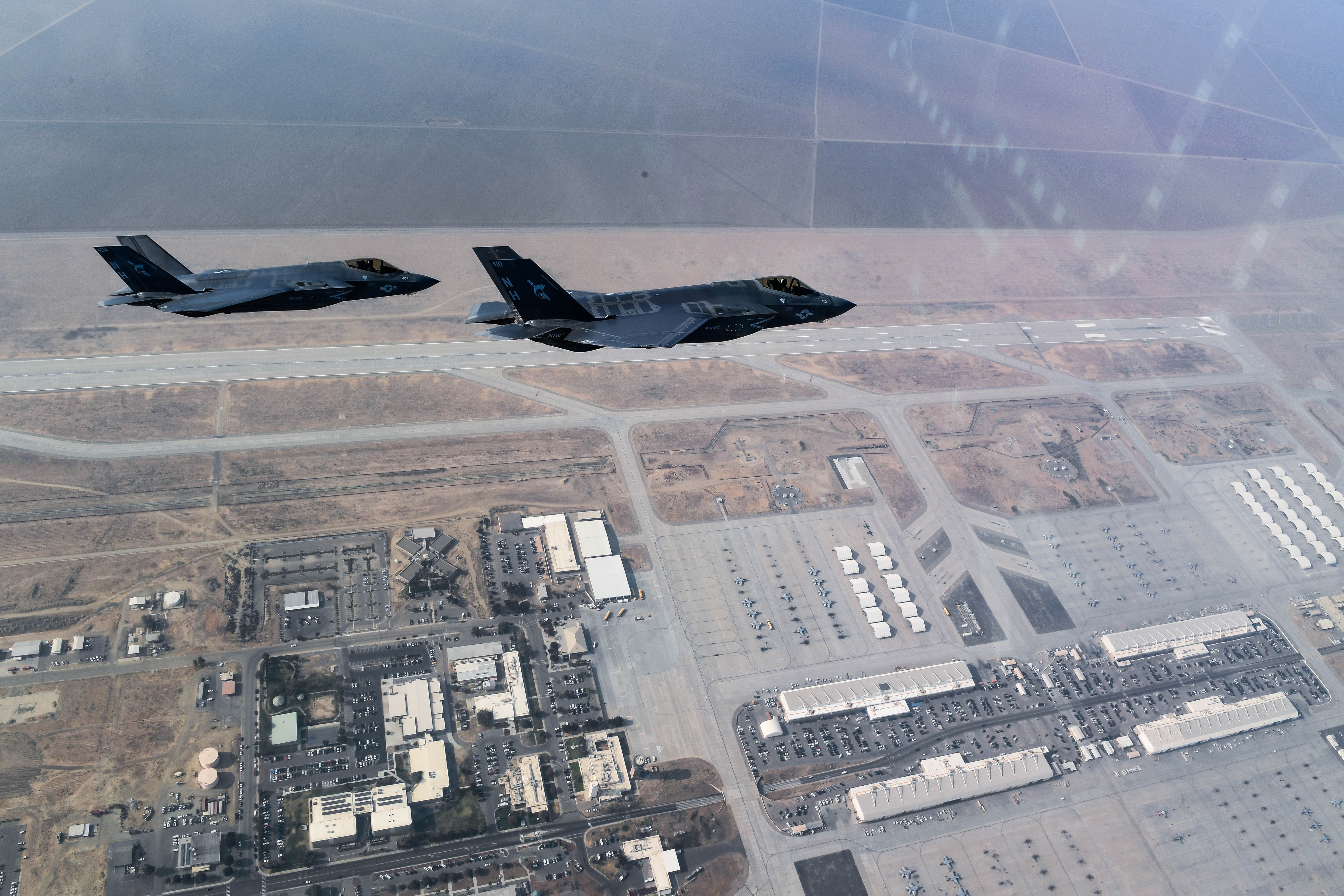
Two F-35C Lightning II fighter jets, attached to the “Argonauts” of Strike Fighter Squadron (VFA) 147, fly in formation for a photo exercise in Lemoore, Calif., Nov. 16, 2018. VFA-147 is the first U.S. Navy Operational F-35C squadron based out of Naval Air Station (NAS) Lemoore. US Navy photo.
The Navy’s future carrier air wing will include a mix of both fourth- and fifth-generation aircraft, with the F-35C and the Super Hornets making up the strike fighter fleet. The recent F-35C deployment aboard USS Carl Vinson (CVN-70) – the first fifth-generation aviation deployment on a carrier – featured a squadron of 10 aircraft, so the Navy could get the F-35 operating forward quickly.
“The primary driver right now is [to] get the maximum capability in fifth-generation platforms forward into the Western Pacific,” Whitesell said.
That’s why the next Navy F-35C deployment by the “Warhawks” of VFA-97 from Naval Air Station Lemoore, Calif., will include 14 planes – the number currently planned for F-35C squadrons.
“As Lockheed Martin continues to build, there is potential to go to 20 total [Joint Strike Fighters]” deployed on a single carrier, Whitesell said. “And now we have to decide whether that’s going to be a single squadron or whether it’s going to be two squadrons, or if [Next-Generation Air Dominance] comes along faster, exactly how we’re going to build JSF out.”
While increasing the number of F-35Cs and EA-18G Growlers in the air wing is a possibility, Whitesell pointed to numerous factors to consider – including the carrier’s “deck density,” the planned introduction of the MQ-25A Stingray unmanned tanker into the air wing, the new Ford-class aircraft carriers and the manning required for operating 20 F-35Cs.
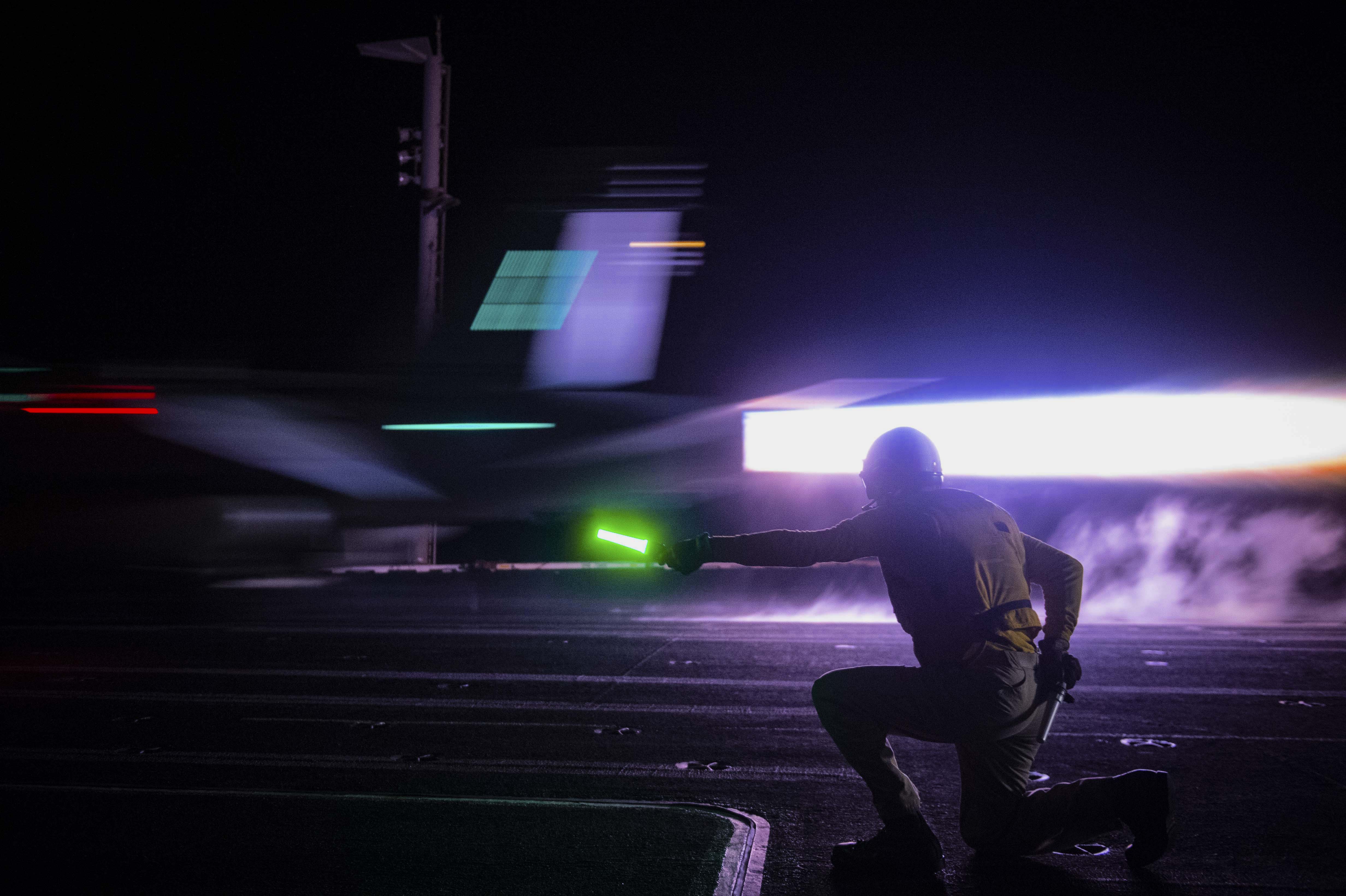
Lt. Gavin Karski signals to a E/A-18G Growler electronic warfare aircraft, attached to the ‘Zappers’ of Electronic Attack Squadron (VAQ) 130, as it launches from the bow catapult aboard aircraft carrier USS Dwight D. Eisenhower (CVN-69) in the Arabian Sea on April 19, 2021. US Navy Photo
“We’re also looking at resizing what the helicopter community’s going to look like on the carrier, because as I plus up from 10 to 14, as I add five MQ-25, [keep the] Growler EA-18G at seven platforms, and then start to think about manned-unmanned teaming, now we have to wait until we transition to Ford-class,” he said. “The difference in the loading from a Nimitz-class to a Ford-class – we just did the experiments up in Lakehurst about three or four weeks ago – and the loading on Ford-class gives us a ton of different options on what future air wings are going to look like. Moving the island aft, having more capacity for storage, Gerald R. Ford is going to be a game-changer for us when it comes down to capability and numbers on a flight deck.”
Vinson’s recent deployment included seven Growlers, two more than the typical five in an electronic attack squadron, and Carrier Strike Group 1 commander Rear Adm. Dan Martin said the crew wanted more after seeing how the platform operated in the U.S. 7th Fleet area of responsibility with the F-35C.
“It’s a brand new aircraft with advanced sensors. So we like to pair them with the Growler to complement each other and when you fly around that theater, collection operations become a big deal,” Martin said of the F-35C during a recent USNI News trip aboard Vinson.
Now that Vinson has completed its deployment to the Indo-Pacific, Whitesell will hear feedback from the first Navy F-35C and CMV-22B squadrons to deploy. The “Argonauts” of VFA-147 Strike Fighter Squadron (VFA) from Naval Air Station Lemoore, Calif., will be key to understanding how the F-35C operated in a maritime environment.
Whitesell said learning how the Afloat Spares Package maintenance kit worked aboard the carrier and how the squadron managed in the Joint Strike Fighter’s global supply chain is at the top of his list of questions now that the first deployment is complete.
“With our international coalition partners flying the platform too, when we ask for a part, did we lose out to another country when we were on deployment? Where were we on the pecking order? Right now, it looks like we fared well, but I need to talk to Lockheed Martin since they run the ASP and the global spares program – [Hybrid Product Support Integration],” he said.
The Air Boss said he also needs to look at the F-35C mission-capable rates during the deployment and see if the numbers are attributable to the supply of parts or maintenance aboard the ship.
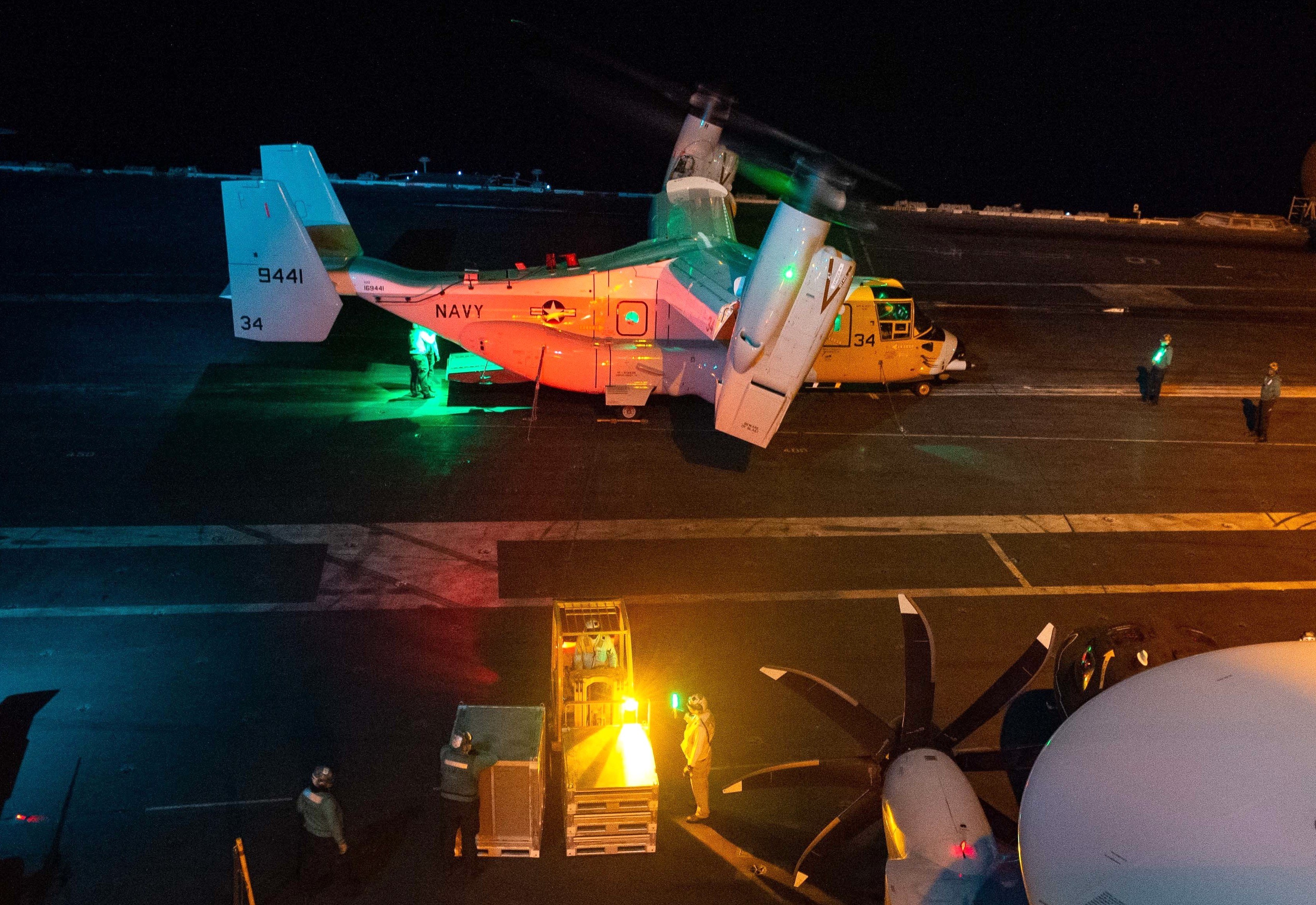
A forklift offloads cargo from a CMV-22B Osprey, assigned to the ‘Titans’ of Fleet Logistics Multi-Mission Squadron (VRM) 30, on the flight deck aboard Nimitz-class aircraft carrier USS Carl Vinson (CVN-70) on Sept. 4, 2021. US Navy Photo
“For that generation five fighter to be fully full-mission capable, what was the percentage rate – which right now looks on paper starkly low, but now, what systems were not up? And how did it really affect – if we had to go into conflict, what would that be? And then what do we have to do to fix it?” Whitesell said.
“Is it a supplies-based system or is it us talking to Lockheed Martin and their subprimes to understand what – through reliability control boards – what parts need to last longer? And then it also goes back to us – we don’t wait on just-in-time delivery of parts on the carrier. We stock the carrier and we have some repair capability on the carrier. What can I do to improve the range and depth of supply items? And then what can I do to potentially repair things on the ship as we move towards that model?”
During the recent deployment, the F-35C squadron found that some seals on the aircraft did not function as planned in the at-sea environment.
“There’s already [a] new design coming out of Lockheed Martin for the new seals,” he said. “So there’s some learning that’s been done. But those platforms have to be remeasured against the baseline to find out how they fared on this deployment.”
Strike Fighter Gaps
While quickly moving the F-35C out to the fleet will help the Navy mitigate the strike fighter shortfall, the service is also working its way out of a backlog for Super Hornet modernization.
The Navy’s stated goal is to eliminate the strike fighter shortfall by 2025, an objective Whitesell described as having several moving parts. According to the service, the current shortfall is 35 aircraft.
The Navy is required to have nine carrier air wings and has called for each air wing to include 44 strike fighters for a total of 396 combat-coded aircraft, according to a 2020 summary reviewed by USNI News. In addition to the strike fighters earmarked for air wings, the Navy says it needs 263 for training and development and 126 in long-term maintenance for a total of 785 fighters. These numbers do not include attrition reserve aircraft. The shortfall is the difference between the number of aircraft in the Navy’s inventory and the number of combat-coded strike fighters it says it needs to meet its missions, or 396.
“As a result of reforms implemented through the Naval Sustainment System—Aviation and Performance-to-Plan initiatives, the U.S. Navy has steadily reduced its strike fighter shortfall over the past several years from 65 in 2018 to less than 35 in 2022,” Whitesell recently told USNI News in a statement. “While the strike fighter inventory has been effectively managed to ensure that operational requirements have consistently been met, a further reduction in strike fighter shortfall will decrease the burden on our fleet maintainers.”
The Navy projected the shortfall would be 44 aircraft in 2022, 40 in 2023, 22 in 2024 and falling to 0 in 2025, according to a briefing provided to Congress with the FY 2022 budget submission and obtained by USNI News.
Working out of the backlog of Block II Super Hornets entering the Service Life Modification program will also help decrease the gap in Navy fighter requirements. The service is currently performing preparation work to ensure Boeing receives aircraft to upgrade in a timely manner and at an appropriate cost.
“We’ve done pre-SLM work based on what Boeing has seen. Now we’re in pre-SLM maintenance corrosion work – and those are the jets that are butting up against 6,000 hours – and once they get done, they don’t go back to the fleet. They go right to Boeing. We’ve completed 19 of those,” Whitesell said.
“We’ve done something called maintenance reset,” he added. “And that is, again, taking the data that we’ve found from Boeing … and we’ve gone back through and put jets through maintenance reset. And we’ve got about 40 jets – Block IIs – that are in maintenance resets. Now those will go back to the fleet, for those birds.”
Boeing’s SLM upgrades are meant to increase the flight hours of the Super Hornets by several thousand, and enable them to transport more weapons at longer ranges, with a little more stealth, bringing them up to Block III configuration. Boston Consulting Group also helped Boeing evaluate how to improve the SLM project so it could quickly move the Block II Super Hornets through the upgrade line and mitigate the backlog.
But the SLM backlog is a concern for Congress, particularly the House Armed Services Committee, which has cited the program for its skepticism of the Navy’s goal to eliminate the shortfall by 2025. Report language accompanying the House’s version of the Fiscal Year 2022 defense authorization bill cited the removal of 104 aircraft from the SLM program, the delayed timeline for the F/A-XX program, and fewer F-35C procurements than previously projected in calling the Navy’s math “highly circumspect.” Prior Navy projections said the service would eliminate the shortfall by 2030.
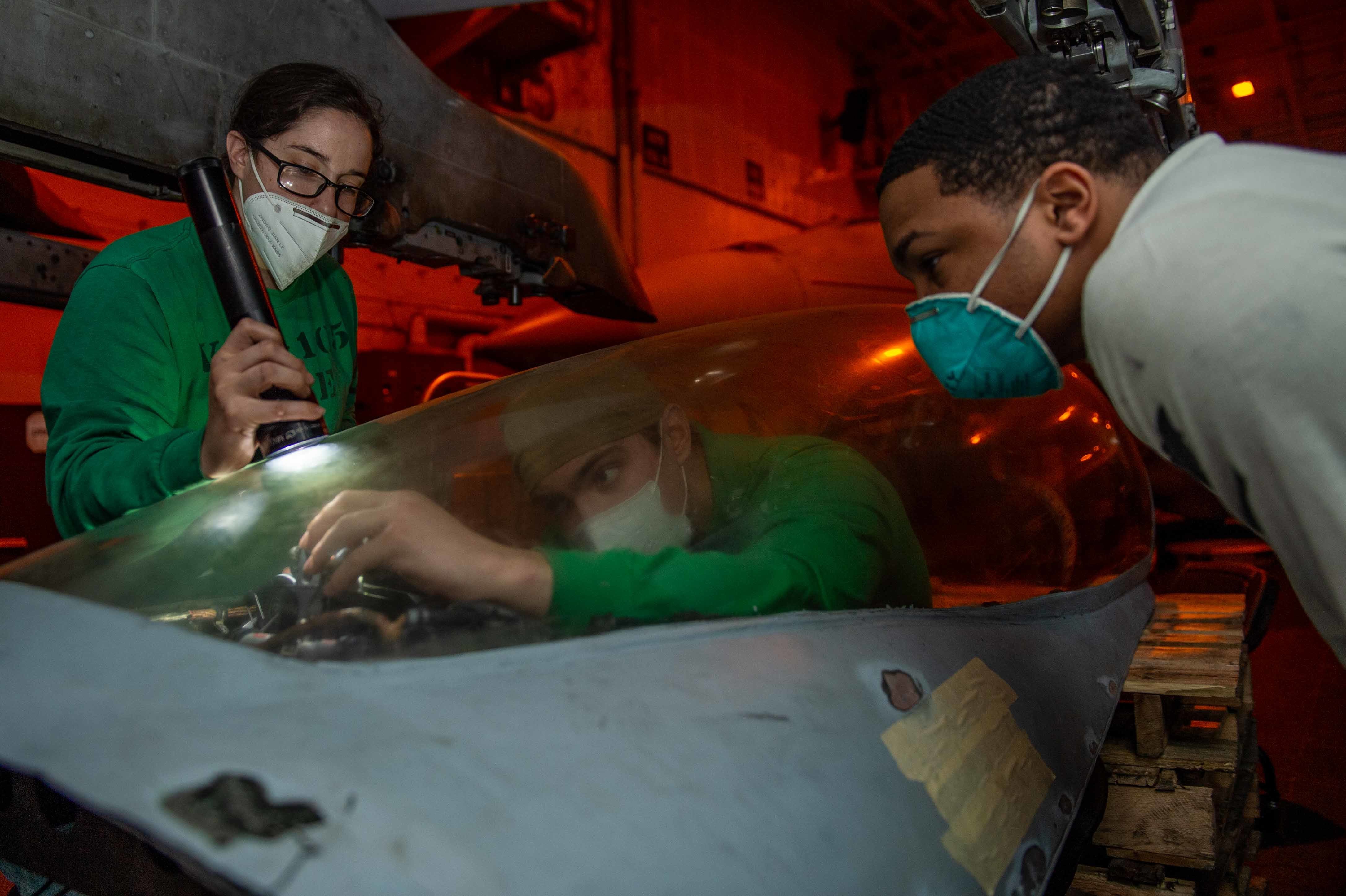
Aviation Structural Mechanic (Equipment) 2nd Class Teresita Joyce, left, from West Covina, California, Aviation Structural Mechanic (Equipment) 3rd Class Nathaniel Tucker, from Gilbert, Arizona, and Aviation Structural Mechanic (Equipment) 3rd Class Jmilriyon Jacobs, from Newport News, Virginia, de-arm a canopy for an F/A-18E Super Hornet attached to the ‘Gunslingers’ of Strike Fighter Squadron (VFA) 105, aboard the Nimitz-class aircraft carrier USS Dwight D. Eisenhower (CVN-69) on Feb. 8, 2021. US Navy Photo
A HASC aide recently told USNI News that the Navy appears to have reduced its force structure requirement for strike fighters, in part by taking away the combat-coded missions from the reserve squadrons, to mitigate the shortfall sooner.
“They also make rosy assumptions … about the performance of the Service Life Modification line in that it’s going to start putting out jets on the schedule that they’re planning for, but they haven’t yet actually executed to date yet, in terms of the time to go through the line,” the aide said.
Whitesell said the Navy is increasing the number of hours the Block III Hornets and the Block II aircraft are slated to fly each year. The service originally planned for each Super Hornet to fly between 210 and 230 hours per year, but now the Navy is increasing that number to 300 hours per year, Whitesell said. With the SLM initiative to upgrade the Block II Super Hornets from 6,000 total flying hours to 10,000, and then increasing the number of hours each aircraft flies per year, the Air Boss said he has a cushion between when the Super Hornets eventually retire in the 2030s and when the Navy’s Next Generation Air Dominance family of systems begins to enter service.
“We did not expect [legacy Hornets] to have to go beyond their service life. And there was no plan. That’s why we were stuck [with] more sand coming out of the hourglass than coming in. Now we’ve planned for it,” he said. “SLM has been a planned process by the program office. Now we have some capacity for Next Generation Air Dominance and F/A-XX development. So it built some space.”
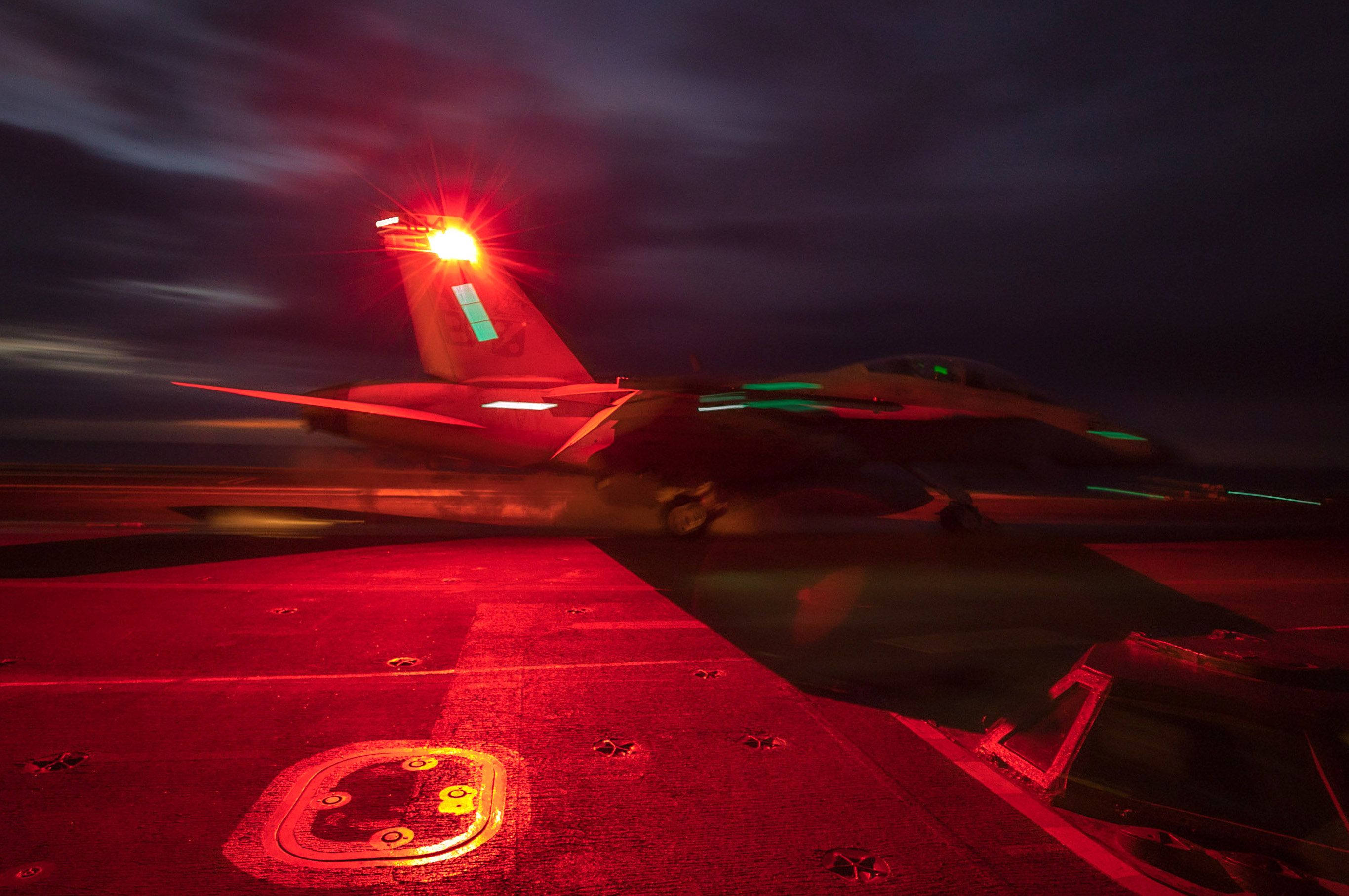
An F/A-18F Super Hornet, attached to the ‘Red Rippers’ of Strike Fighter Squadron (VFA) 11, lands on the flight deck of the Nimitz-class aircraft carrier USS Harry S. Truman (CVN-75), Jan. 7, 2022. US Navy Photo
By increasing the number of hours the new Block III aircraft and the upgraded Block II aircraft can fly each year, the Super Hornets’ service lives have been extended by roughly 13 years, Whitesell said.
Eliminating the shortfall by 2025 is also contingent on Lockheed Martin delivering the F-35C on time.
“We’ve already had 15 deliveries out of SLM from Boeing, so the deliveries have already started – the fact that Lockheed Martin will ramp up their deliveries when it goes into the model, that’s why Adm. Loiselle has said that by ’25 … we won’t have a strike fighter inventory shortfall. And that’s the model,” Whitesell said, referring to the director of the chief of naval operation’s air warfare directorate (OPNAV N98).
But HASC is not convinced. A second committee aide noted that the Navy’s FY 2022 projections for F-35C procurement decreased from its FY 2021 projections. The service’s FY 2022 outlook showed it purchasing 20 F-35Cs each year between FY 2023 and FY 2026, while the prior year’s projections showed a buy of 22 F-35Cs in FY 2023, 22 in FY 2024 and 24 in FY 2025, according to the summaries reviewed by USNI News. The changes amount to a decrease of 8 aircraft through the year the Navy says it will eliminate the shortfall.
The summaries also show the shortfall projections increasing between FY 2021 and FY 2022.
“Overall, they decreased their strike fighter requirements in their inventory, which kind of had an artificial effect of ‘oh look … we don’t have as many strike fighters that we need to replace now,’” the first committee aide said.
“Basically they’re decreasing their force structure and then marketing it as, ‘oh look we’re resolving our strike fighter shortfall five years early,” the aide added.
Asked how the Navy would go from a 22 aircraft shortfall in FY 2024 to 0 in FY 2025, a spokesman for Naval Air Forces pointed to the Navy’s decision to use U.S. Air Force F-16 Falcons and Swiss Air Force F-5 Tigers for the service’s adversary squadrons.
“[I]n PB22 the Navy changed the Adversary Recapitalization Plan so that F/A-18C/D Hornets in two adversary squadrons will now be replaced with F-16 Fighting Falcons from the U.S. Air Force and F-5 Tiger IIs from the Swiss Air Force, instead of transitioning to Super Hornets in FY25,” Cmdr. Zachary Harrell told USNI News in a statement. “This resulted in significant savings in operational cost to our adversary units [F-16s and F-5s are less expensive to maintain and operate than F/A-18E/Fs] and a reduction in 20+ Super Hornets required in the U.S. Navy strike fighter inventory [i.e. a 20+ reduction in the SFSF by 2025].”
“Future budgets may affect strike fighter inventory management, but the Naval Sustainment System—Aviation and Performance-to-Plan initiatives continue to make strides in returning long-term-down aircraft to the fleet and the current U.S. Navy strike fighter inventory is the healthiest it has been in the last 20 years,” Harrell added.
But the committee in the report accompanying its version of the FY 2022 defense policy bill also voiced concern over this plan because the F-16s and F-5s will not be capable of surging for combat if necessary. Like the reserve squadrons, the panel at the time wrote that the Navy is taking away the combat-coded mission requirement from the adversary squadrons to more quickly eliminate the strike fighter shortfall.
“[W]ith the Navy transitioning their adversary squadrons to F-16 and F-5 aircraft, they’ve eliminated a longstanding mission requirement of the adversary squadrons in that they could in the past be available and counted as combat-coded F-18 force structure if ever needed to support a warfighting contingency operation,” the first committee aide told USNI News. “Since F-5 and F-16 aircraft they plan to use will not be combat-capable, the Navy has less combat coded strike-fighters in their inventory to be concerned about keeping relevant and crews proficient.”
Mission-Capable Rates
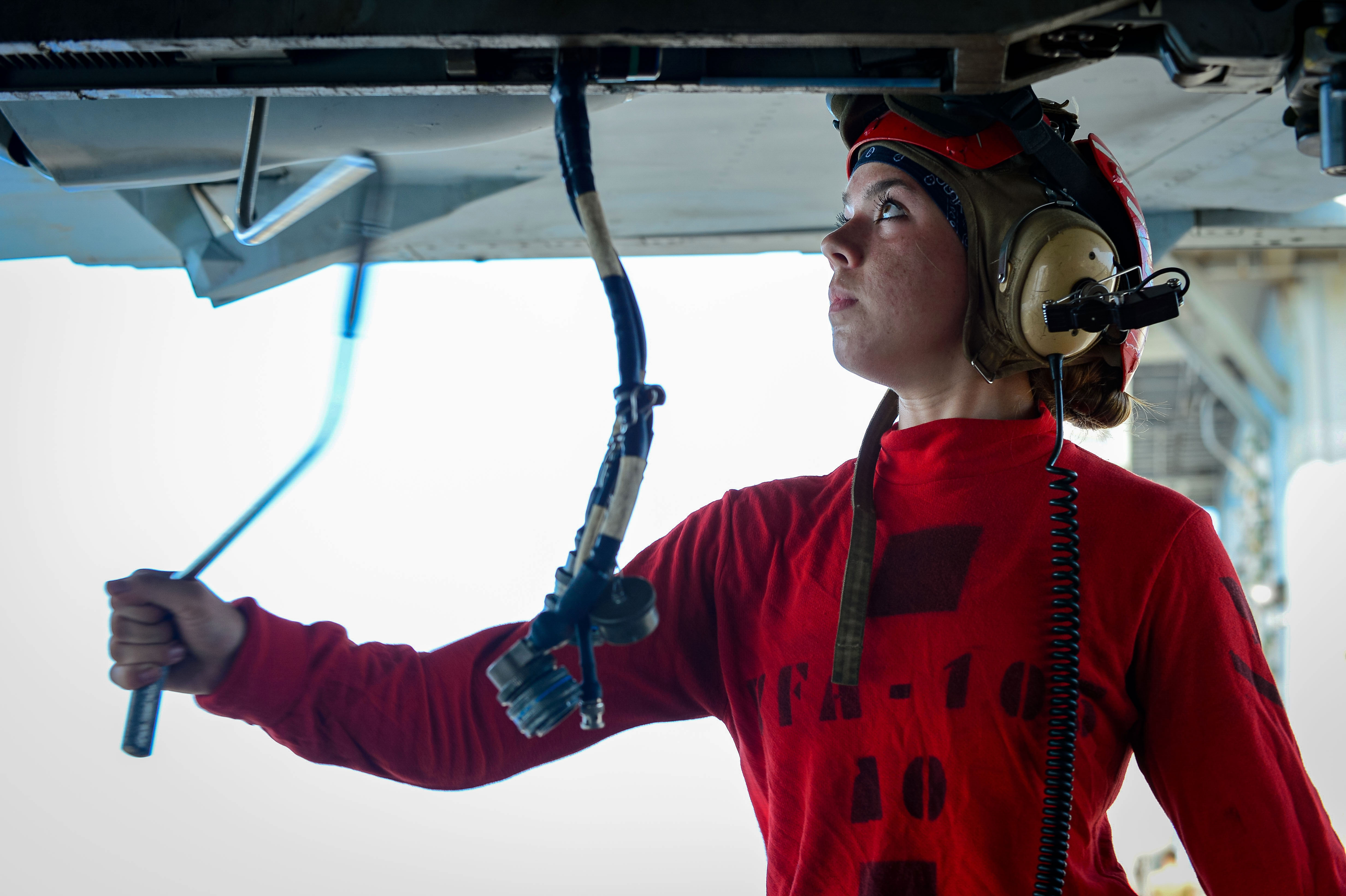
Aviation Ordnanceman 3rd Class Amber Krolicki makes adjustments prior to mounting ordnance onto an F/A-18E Super Hornet fighter, attached to the ‘Gunslingers’ of Strike Fighter Squadron (VFA) 105, aboard the aircraft carrier USS Dwight D. Eisenhower (CVN-69) in the Arabian Sea on May 31, 2021. US Navy Photo
While addressing the strike fighter shortfall will help the Navy deploy more F-35Cs to the U.S. military’s priority region of the Indo-Pacific, the service also remains focused on the readiness of aircraft in its inventory.
More than three years after Defense Secretary Jim Mattis set a requirement for the Super Hornet fleet to achieve an 80 percent mission-capable rate, the Navy has increased the readiness goals for the strike fighters. While 341 mission-capable Super Hornets was the previous goal, Whitesell said the Super Hornets’ new objective is 360 jets.
“We’re pushing up in the 350s – the high 340s to 350s – and we’ve touched 360 about nine times since we’ve changed the number to 360. What we have found is that it’s not the NSS process that needs changing,” Whitesell said, referring to the Naval Sustainment System program, which adopts commercial aviation’s best maintenance methods to make Navy aircraft sustainment more efficient.
NSS is working, Whitesell said, but the impediment to hitting 360 mission capable Super Hornets is the logjam of Block II aircraft waiting for Service Life Modifications.
“We’ve found that the jets that are in our reporting inventory – the jets that are going into SLM, the ones that are in backlog at SLM – those numbers have been the biggest driver [determining if] we get to 360,” he said. “Once we get it moving so that it gets to the 12- to 15-month delivery, it gets down to the $6 to 8 million cost for delivery, and we start that assembly line of SLM birds coming out – it’s the inventory, not the process, that’s driving the road to 360.”
The Navy also now has a consistent method for calculating these mission-capable numbers based on operational planning and combatant commanders’ needs, whereas before, the service lacked a standardized formula for determining the rates.
“We applied it to two different reference models. One was the most tasking [operational] plan and the other was a set of plans that are run by the Joint Staff. So we didn’t trust one model. We calculated it both ways and we found out the numbers and the methodology for calculating MC – we could come up with a standardized set of numbers that, number one, was approved by the combatant commanders and, number two, with any MC number, there’s money attached to that because you’ve got to maintain it. So now we found something – a capability, or capacity – in building MC that [the office of the chief of naval operations] could agree with because they’ve got to pay for it,” Whitesell said.
The Navy has defined “north star” numbers, or a target number of mission-capable aircraft, for each platform. The objectives are 86 EA-18G Growlers, 34 E-2D Advanced Hawkeyes, 77 P-8A Poseidon aircraft, 128 MH-60S helicopters, 126 MH-60R helicopters, and 16 CMV-22Bs.
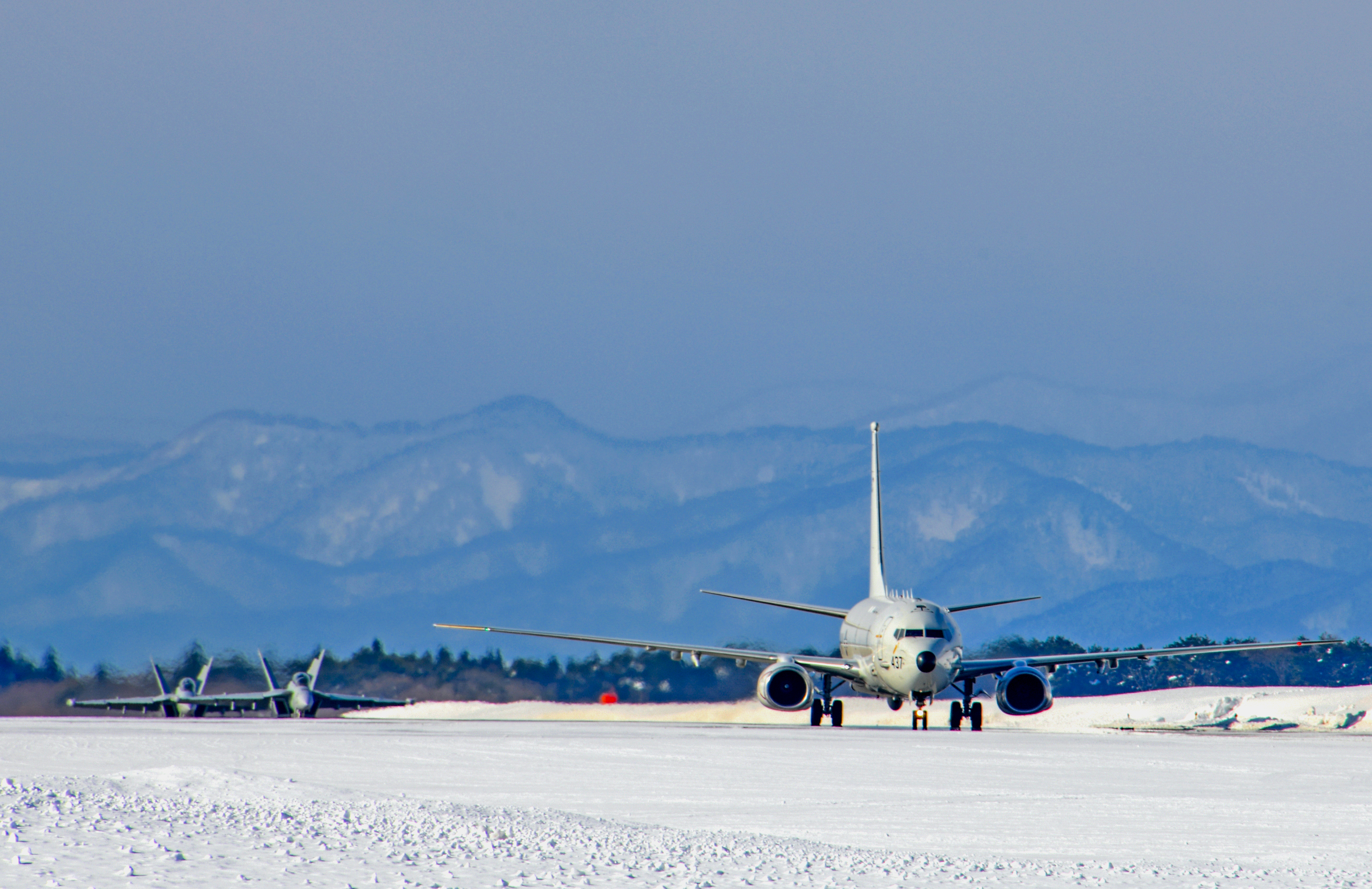
EA-18G Growlers, assigned to the ‘Black Ravens’ of Electronic Attack Squadron (VAQ) 135, and a P-8A Poseidon, assigned to the ‘Fighting Tigers’ of Patrol Squadron (VP) 8, taxi down the flight line at Misawa Air Base on Jan. 6, 2021. US Navy Photo
The P-8s and MH-60 helicopters are currently above their respective target mission capable numbers, while the Growlers and Ospreys are each fewer than 10 below their targets, Whitesell told USNI News in a statement this month. Whitesell noted the Navy is still getting deliveries for the Osprey squadrons, meaning the target number for the platform is more than what the Navy has in its inventory.
The Marine Corps is also following the same methodology to determine the mission-capable numbers for its aircraft.
“Now we’ve got numbers that apply to every platform in our inventory. And the Marine Corps bought off on a methodology to calculate their MC numbers too, and we’re using the same methodology across [the] Navy and the Marine Corps to determine what MC is like,” Whitesell said in the interview last month.
Finding Efficiencies

Navy Aviation Boatswain’s Mate (Equipment) 2nd Class ShaMarie Martin, from San Diego, Calif., left, and Aviation Boatswain’s Mate (Equipment) Airman James Luna, from Flint, Mich., signal to launch an F/A-18E Super Hornet, assigned to the ‘Blue Diamonds’ of Strike Fighter Squadron (VFA) 146, from the flight deck of the aircraft carrier USS Theodore Roosevelt (CVN-71) on March 11, 2021. US Navy Photo
Whitesell’s efforts within naval aviation come amid an unpredictable budget environment. While service officials have forecast flat budgets in the coming years, it’s unclear what the Biden administration’s upcoming FY 2023 submission will look like. USNI News recently reported that the Defense Department’s FY 2023 topline could be more than $770 billion, which would be about a $55 billion increase from FY 2022.
The Air Boss has been directed to look for money to maintain aviation readiness within his type command. Vice Chief of Naval Operations Adm. Bill Lescher told Whitesell that any money he saves, he can keep within the naval aviation enterprise.
“Where can we find efficiencies, ruthlessly look at our processes, understand where we can do things faster, cheaper, we can make sure that parts are more reliable – working with primes, as well as other contractors,” Whitesell said.
“We can look at how we operate them on what we’re doing with some of the platforms and then how we can squeeze some of the money out. And we’ve found money to do that,” he added. “So this isn’t one where I just go with hat in hand saying, ‘If you want to have this requirement, you’ve got to pay me.’”
One area where the Navy could find efficiencies, according to Whitesell, is in naval aviation’s partnership with Naval Supplies Systems Command.
“They do the reliability control boards. So they know what we’ve bought, what the components are specc-ed to last for and then they do the analysis on every part in every platform that is a high priority part or a high fail time part. And then we try to understand why it fails,” he said.
For example, Whitesell said NAVSUP helped the Navy figure out what parts for the E-2D Advanced Hawkeye needed design tweaks or repairs.
“They found out why they were failing, [went] back to the contractors … and they’ve implemented some repairs on those components, or changed the engineering, changed the design form,” he said. “So time on-wing is what we’re measuring right now, and ultimately we just want the things to stay on the wing the way they were designed.”

